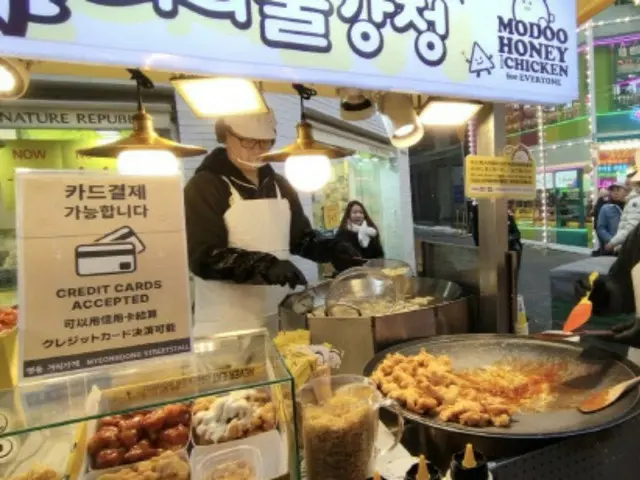The store has previously received complaints from tourists and others about being ripped off. The COVID-19 virus pandemic (global pandemic) has come to an end, and immigration regulations have been significantly eased.
As a result, the number of foreigners visiting South Korea is increasing, and tourists are returning to Myeong-dong. South Korea aims to attract 20 million foreign tourists this year, and the negative image of major tourist spots is
I would like to get rid of this problem as soon as possible. Speaking of Myeong-dong, it is a representative tourist spot in Korea that every foreign tourist who has traveled to Seoul must visit at least once. The place name Myeong-dong was the administrative district at the time.
It originates from ``Myeongnaebang'', which was an area. During the Japanese colonial period, it was called "Meiji Town" and developed as a Japanese residential area. It flourished as a center of culture and entertainment. At that time, the stores in Myeong-dong were about
It is said that 90% of the company was run by Japanese people. In the 1930s, it became a competitive area with five department stores, including Mitsukoshi Department Store.
After the liberation, in 1946, the word ``Ming'' in ``Meireibo'' was combined with the meaning ``a bright town where many people gather.''
The current place name ``Myeong-dong'' was born. It was heavily damaged during the Korean War (1950-53), but since 1956, urban redevelopment has replaced skyscrapers, financial institutions, offices, etc.
It was completed one after another, and in the 1960s and 1970s it revived as one of Seoul's most representative downtown areas. After that, after the Seoul Olympics and democratization, Seoul's downtown area was no longer concentrated in Myeongdong, and for a time
Although the area lost its vibrancy, it once again became a popular downtown area when a large fashion building opened. The number of foreign tourists increased, and around 2004 there was a boom in the Korean TV series ``Winter Sonata.'' At that time, people walking on the street
There were more Japanese than Koreans. Later, after the boom ended, Myeong-dong shifted its target to mainly Chinese tourists and tried to attract more tourists.
However, the appearance of the city has changed completely due to the COVID-19 pandemic. There were no foreign tourists in sight, and many stores were closed or closed down.
Since then, the number of foreign visitors to South Korea has increased as the pandemic subsided and immigration regulations were significantly eased. The bustle of the past has returned to Myeong-dong.
Myeong-dong is lined with street stalls, and rip-offs aimed at foreign tourists have been a problem since before the coronavirus outbreak. In 2016, the then
President Park Geun-hye herself even called for eradication. At that time, Chinese tourists visiting South Korea during the Lunar New Year holidays would buy a nori roll for 10,000 won in downtown Seoul.
He was forced to buy it for about 1,100 yen (at current exchange rates), and after returning to the country, he made the news on Twitter (currently known as X). At a conference on strengthening the competitiveness of the cultural tourism industry, Mr. Park said,
) Charging a high price of 10,000 won for each bottle is an act that drives away tourists. "It would be contradictory to hope for a large number of tourists to come because of something like that."
Since October last year, Seoul's Jung-gu, where Myeong-dong is located, has designated the entire area as an area where price display is mandatory. Stalls and stores in the area display prices.
Failure to do so will result in a fine of up to 10 million won. However, many stalls only accept cash payments and no records are kept, which leads to high prices.
It was also pointed out that In December last year, a student from Estonia who was studying abroad in Korea noticed that Korean-style taiyaki ``poonoppan'' was being sold at a stall in Myeong-dong for 5,000 won for a pack of four.
Surprised by the results, he posted a related video on YouTube. Koreans who watched the video made comments such as, ``The average price in Seoul is 1,000 won for 3 pieces. 5,000 won for 4 pieces is a scam.''
ment has gone up. In an effort to further eradicate rip-offs following the mandatory price display mandate imposed in October last year, the district announced on the 5th of this month that credit cards with payment records will be sold at food stalls in Myeong-dong.
The company announced that it will make payments possible and ensure transparency. The district said, ``Amidst concerns such as rip-offs and forced cash payments, we are encouraging merchants operating street stalls to voluntarily act in order to restore trust.''
We will proactively implement this initiative starting next month." The city also decided to consult with the ward in advance if the selling prices of 10 popular menu items, such as taiyaki and oden, are to be raised. Korea
According to national media, an official from the Myeong-dong Welfare Association, a merchant association made up of stall owners, said, ``We will work proactively to spread a positive image of Myeong-dong food stalls.''
Myeong-dong is a popular tourist spot that represents Korea. Some say, ``If Myeong-dong does not change, the standard of South Korea's tourism industry will not change.''
2024/02/07 11:51 KST
Copyrights(C)wowkorea.jp 5

